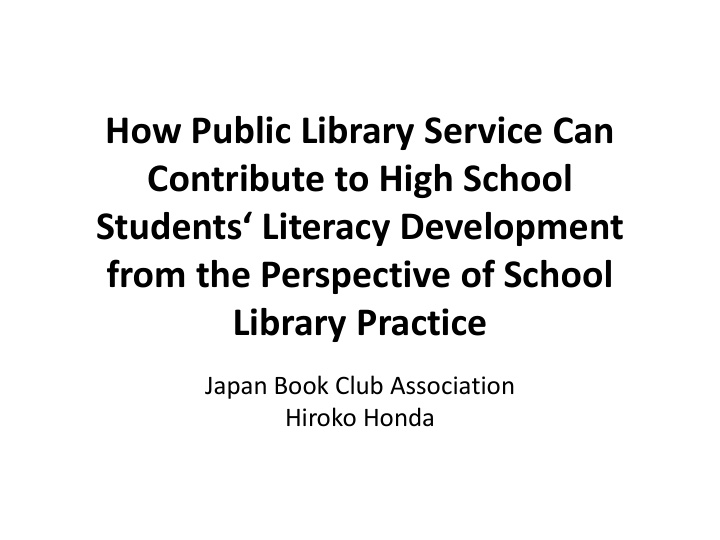



How Public Library Service Can Contribute to High School Students‘ Literacy Development from the Perspective of School Library Practice Japan Book Club Association Hiroko Honda
Keywords UNESCO, FILA, High School, School Library, Public Library, National Library, EFA, ESD, YALSA, Leadership, Teen Services Evaluation Tool, Marketing and Promotion, MEXT, NIER, Book Club, NDL, ILCL, Zest for Life, Language Education, Hiroshima Prefectural Library, YA, Framework, Collaboration
The Purposes ① Report on the enhancement of educational activities for Education for All and Education for Sustainable Development through a case study observation as a library practitioner at a high school in Hiroshima, Japan, from 2008 to 2011. ② Enhance opportunities for international communication by introducing quality research and practice conducted in Japan and Korea based on the idea of learning from each other. ③ Inform the great enhancement of collaborative practice and research between high schools in Hiroshima, the Hiroshima Prefectural Library, National Diet Library and International Library of Children’s Literature through one case study observation as an example.
④ Introduce library-based educational activities under the school principal’s leadership to contribute to the educational research activities of the National Institute for Educational Policy Research (NIER) and the National Federation of Educational Policy Research Institutes through reading literacy development utilizing the book club method. ⑤ Contribute to research conducted by the National Library of Korea based on leadership principles. ⑥ Develop the global library for the purpose of promoting world peace and obtaining funding for key organizations at the local, national, and international levels.
⑦ Apply the model to other educational contexts in Japan and test this model and other research in various countries for the purpose of providing quality education based on leadership principles.
Key Ideas • Experience exchange and knowledge transfer are crucial means of breaking through boundaries between people and countries (Hamada, 2011) • Education is key in creating sustainable societies and fostering world peace. • Everyone has the right to education. • Literacy is a fundamental right and the foundation for lifelong learning. • The holistic view of lifelong learning has improved.
Education for All (EFA) ・ World Conference on Education for All (Jomtien, Thailand, March 1990) ・ World Education Forum (Dakar, Senegal 2000) 6 goals with wide-ranging targets ・ Goal 6 - improving the quality of education and fostering excellence among all citizens of the world
・ Kōichirō Matsuura ・ Joint Cooperation of Asia-Pacific Cultural Center for UNESCO (ACCU) and MEXT ・ Korean National Commission for UNESCO ・ Director-General Irina Bokova’s visit to Gunnae Elementary School in Paju-city ・ UNESCO Associated Schools Project Network (ASPnet) ・ There is nothing more important than peace and learning to live together
Recommend
More recommend